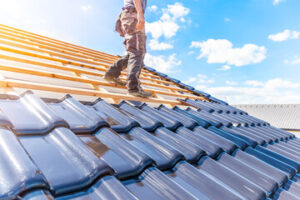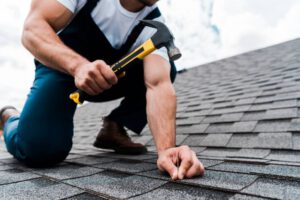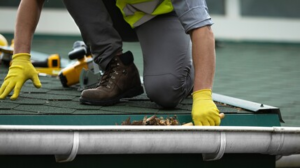Baton Rouge Roofing Contractors have years of experience managing various aspects of the re-roofing process. They also know how to assess the nature of each project to determine its requirements in terms of manpower, equipment, and materials.

Besides checking the reviews, homeowners should look for insurance accreditation and licensing proof. In addition, they should insist on a written estimate.
The roof of a home is an integral part of the overall structure, and can be affected by many factors. Hence, it is important to find a qualified roofing contractor to ensure that your roof is in good condition and protected from the elements. Roofing contractors have the expertise to repair, replace or inspect any type of roof. They also have the knowledge to select the best materials for your roof and to install them correctly. Moreover, they can offer labour and shingle warranties to protect your investment.
Moreover, roofers are usually familiar with building code requirements and can help you obtain the necessary permits for your project. They may also be able to recommend additional products or services that can improve the performance and durability of your roof. In addition to roofing, they can also handle other aspects of your home’s exterior, such as siding and windows.
Another benefit of hiring a roofing contractor is their experience with handling insurance claims. This can save you a lot of time and hassle, and may even result in higher compensation from the insurer. In addition, a roofing contractor can provide you with detailed estimates and specifications of the work to be performed. This can help you compare prices and quality of service.
It is important to find a reputable roofing company that has a history of excellent customer service and high-quality workmanship. You should also check whether they have a business license and are insured for liability. If you are unsure, ask them to email copies of their state-issued licenses and insurance validation. If they cannot do so, then you should look elsewhere.
Roofing contractors should be licensed and insured to perform residential and commercial roof installation. In addition, they should have a strong work ethic and be able to communicate with customers clearly. If you are considering using a roofing contractor, make sure to get estimates in writing and compare their prices, warranties, and timelines. It is also a good idea to ask the roofing contractor for references from previous clients. If the roofing contractor does not have any, this is a red flag and should be a warning sign.
License
Licensed roofers are required to provide a written contract for their work, which highlights the scope of the job, the materials needed and the timeline. This protects the homeowner from being charged for work that is not performed or that was done incorrectly. Licensed roofers also carry liability and worker’s compensation insurance, which covers any costs associated with workers damaging the property or hurting themselves while working on the site. They may also be members of a trade organization, such as the Roofing Contractors Association of New York.
Many states require roofers to hold a state license to work in the field. The requirements vary from state to state, but most require pre-licensing training, an exam, and proof of insurance and work experience. Some states also have licensing at the county and municipal levels, so it is important to check your local requirements before hiring a roofer.
The state of Alaska requires a specialty contractor license for roofers, which is available through the Department of Commerce, Community and Economic Development, Division of Corporations, Business and Professional Licensing. To qualify for the license, you must pass a trade and business exam, and provide proof of insurance and worker’s compensation coverage. In addition, you must be bonded.
In Maryland, roofers are not required to have a state license unless they perform other home improvements along with their roofing jobs. Those who do need a state license must register with the Home Improvement Commission, and must have at least two years of experience. You can find more information about these requirements on the MHIC’s website.
In Idaho, roofers are required to register with the State Contractors Board. To obtain a contractor’s license, you must submit your finances, pass a trade and business exam, and show proof of worker’s compensation and liability insurance.
In Montana, roofers are not required to have statewide licensure, but they must register with the state’s Department of Labor and Industry. In Nebraska, most licensing regulations are handled by the counties and municipalities, so it is best to check with your local offices to determine if there are any licensure requirements for roofers.
Warranties
When it comes to roof repairs or replacements, warranties are an important factor in choosing a roofing contractor. They help to manage expectations by establishing in writing all the details about the installation, serving the best interests of both homeowner and contractor. A warranty can cover the cost of materials, labor and even the product itself. It can also provide peace of mind to homeowners who are concerned about the quality of workmanship and longevity of their roofing products.
It is important to understand the different types of roof warranties before selecting a roofing contractor. While most contractors offer standard manufacturer and workmanship warranties, some also offer enhanced or extended warranties. A system warranty, for example, combines product and installation warranties into one. It is available only when all the components in a roofing system are from the same manufacturer and are installed according to the manufacturer’s specifications.
The type of warranty a roofing contractor offers will depend on their expertise and the type of roof they are installing. A standard manufacturer warranty covers factory defects in shingles and other roofing material. It does not, however, cover problems caused by improper installation or natural conditions. For example, a standard manufacturer warranty won’t cover shingle damage caused by hail or wind. It also doesn’t cover shingles that have been damaged by excessive heat or sun exposure.
A contractor’s workmanship warranty is a critical component of any roof installation project. A reputable roofing contractor will offer a written warranty that includes the duration of coverage and what is covered. It should also state what isn’t covered, such as water leaks caused by poor design or the use of substandard materials.
Manufacturers also offer extended warranties on their roofing products, including shingles and other materials. These warranties are typically transferable to a new homeowner, providing additional protection for your investment. In addition to extending the life of your roof, they can also increase its value when you go to sell.
It is important to note that many roofing warranties require that you register them within a certain period of time after the roof is installed. Failure to do so may void your warranty. If you’re unsure how to register your warranty, your roofing contractor will be able to guide you through the process. It is also crucial to read your warranty carefully and understand the terms and conditions.
Reputation
It is important to find a roofing contractor that has a good reputation. This will allow you to rest assured that you are getting the best possible work done on your home. Word of mouth is always a great way to start, but you should take it one step further by checking out the Better Business Bureau (BBB). The BBB provides a useful overview of a company, including any filed complaints and licensing information. It will also give you a feel for how long the company has been in business, which is another good indicator of quality work and ethical practices.
It’s also a good idea to look at online reviews and ratings. A good roofing company will have a professional website and social media presence, as well as positive customer feedback on review sites such as Google, Facebook, GuildQuality, Angie’s List and HomeAdvisor. When looking at these sites, be sure to read the reviews carefully and pay special attention to how the company treated its customers and how honest it was.
A big red flag to watch out for is contractors who refuse to provide a written estimate of the job costs. This is often a sign that the contractor is trying to scam homeowners by taking advantage of their insurance claim money. This type of contractor will often install substandard products and pocket the difference in cost, then submit paperwork to the homeowner with a higher total than what was actually installed.
Lastly, it is a good idea to make sure the roofing company you choose is locally owned and operated. This will ensure that they have a stake in the community and are committed to staying around for the long term. It will also give you peace of mind knowing that if anything goes wrong, the local office can help you resolve your issue. In addition, a locally owned and operated roofing company will often offer more competitive prices than national or national companies. They will also be more likely to have a wide selection of roofing materials and colors to choose from.






